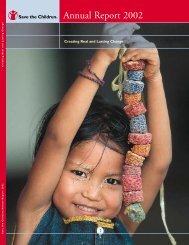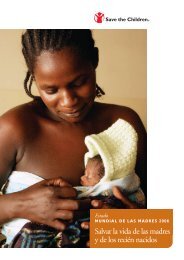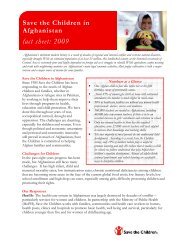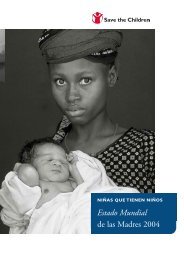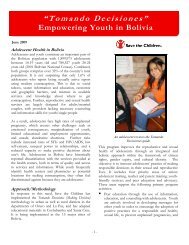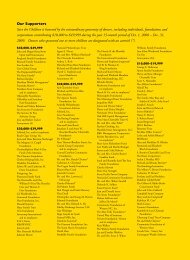for pdf - Save the Children
for pdf - Save the Children
for pdf - Save the Children
Create successful ePaper yourself
Turn your PDF publications into a flip-book with our unique Google optimized e-Paper software.
A Strong Commitment to <strong>the</strong><br />
COVER PHOTO: MICHAEL BISCEGLIE<br />
2
Poorest <strong>Children</strong> and Mo<strong>the</strong>rs<br />
<strong>Save</strong> <strong>the</strong> <strong>Children</strong><br />
has been addressing <strong>the</strong> critical needs of<br />
children and families in <strong>the</strong> Middle East<br />
since 1953, when our work in Lebanon<br />
began. That work expanded to <strong>the</strong> West<br />
Bank and Gaza in <strong>the</strong> 1970s and to<br />
Egypt and Jordan in <strong>the</strong> 1980s.<br />
In <strong>the</strong> Middle East, where <strong>Save</strong> <strong>the</strong> <strong>Children</strong> has worked <strong>for</strong> nearly<br />
50 years, <strong>the</strong> children and families most in need face . . .<br />
• Poverty and lack of services to <strong>the</strong> poor, especially among Palestinian refugees and o<strong>the</strong>r displaced persons.<br />
• Inadequate educational systems, with poor teaching methodologies, outdated curricula, large classrooms,<br />
and minimal recreational facilities.<br />
• Unsafe water and sanitation systems.<br />
• Rural/urban migration because of unemployment or unrest, separating and displacing families.<br />
• A rapidly growing youth population.<br />
• Limited but increasing citizen participation in governance.<br />
• Political unrest, economic instability, and violence, especially in <strong>the</strong> West Bank and Gaza.<br />
With extensive programmatic experience and policy<br />
expertise, today <strong>Save</strong> <strong>the</strong> <strong>Children</strong> is a leader and<br />
an innovator in <strong>the</strong> Middle East, earning <strong>the</strong><br />
respect and trust of local communities, partners, and<br />
government ministries that collaborate with us on<br />
behalf of over a half-million of <strong>the</strong> region’s neediest<br />
residents—children and <strong>the</strong>ir mo<strong>the</strong>rs.<br />
3
Strategies <strong>for</strong> Self-Sufficiency<br />
PHOTO: WILLIAM FOLEY<br />
A mo<strong>the</strong>r and her child participate in <strong>Save</strong> <strong>the</strong> <strong>Children</strong>’s health and o<strong>the</strong>r programs in Lebanon.<br />
In each country where we work, <strong>Save</strong> <strong>the</strong> <strong>Children</strong>’s<br />
education, health, economic opportunities, and<br />
humanitarian assistance initiatives empower children<br />
and adults, promoting <strong>the</strong>ir self-sufficiency and<br />
contributing to a more stable civil society.<br />
4
and Real and Lasting Change<br />
TOP PHOTO: MICHAEL BISCEGLIE; BOTTOM PHOTO: FIELD STAFF<br />
<strong>Save</strong> <strong>the</strong> <strong>Children</strong><br />
creates real and lasting change<br />
<strong>for</strong> children and <strong>the</strong>ir mo<strong>the</strong>rs in <strong>the</strong><br />
Middle East first by investing in <strong>the</strong>ir<br />
education and <strong>the</strong>n improving <strong>the</strong>ir<br />
health and economic opportunities,<br />
while addressing <strong>the</strong>ir physical and<br />
emotional well-being.<br />
Top: A young girl takes a drink of water from a well constructed by <strong>Save</strong> <strong>the</strong> <strong>Children</strong> in <strong>the</strong> West Bank.<br />
Below: A girl takes her studies seriously in a <strong>Save</strong> <strong>the</strong> <strong>Children</strong> education program in Egypt.<br />
5
PHOTO: MICHAEL BISCEGLIE<br />
First, invest in<br />
EDUCATION<br />
1.<br />
<strong>Children</strong> and youth ages 0-25 make up nearly 60 percent of <strong>the</strong> population in <strong>the</strong><br />
Middle East. The many obstacles to <strong>the</strong>ir growth and development—poverty,<br />
political unrest, economic instability, and an inadequate and unequal educational<br />
system—can be mitigated with education.<br />
Because learning begins at birth and<br />
continues throughout life, <strong>Save</strong> <strong>the</strong><br />
<strong>Children</strong>’s education programs are<br />
intergenerational and interrelated. They<br />
are unique in <strong>the</strong>ir emphasis on <strong>the</strong><br />
equal participation of girls, <strong>the</strong><br />
engagement of adolescents, and <strong>the</strong><br />
promotion of understanding and<br />
goodwill among communities. Key<br />
areas of programming are early<br />
childhood development (ages 0-5),<br />
primary education, especially <strong>for</strong> girls<br />
(ages 6-13), youth development (ages<br />
14-19), and adult literacy (ages 19+).<br />
A <strong>Save</strong> <strong>the</strong> <strong>Children</strong> early childhood development center in Egypt promotes<br />
school readiness.<br />
“My name is Eman. I’m married with five<br />
children and working as a first grade teacher<br />
[in Jordan]. I was introduced to <strong>Save</strong> <strong>the</strong><br />
<strong>Children</strong>’s Early Childhood Development<br />
program while volunteering…I was trained on<br />
how to deal with young children and <strong>the</strong><br />
importance of active learning and play on <strong>the</strong>ir<br />
development. I enjoy <strong>the</strong> activities and believe<br />
in <strong>the</strong>ir positive effects on children.”<br />
—A volunteer mo<strong>the</strong>r in a <strong>Save</strong> <strong>the</strong><br />
<strong>Children</strong> early childhood development<br />
program in Jordan<br />
Early childhood development<br />
programs stimulate growth and<br />
development and prepare young<br />
children <strong>for</strong> school. A “learning through<br />
play” approach is used with <strong>the</strong><br />
children, and <strong>the</strong> important role of early<br />
childhood education <strong>for</strong> school preparedness is<br />
emphasized among <strong>the</strong> children’s families. In our<br />
programs in Egypt, <strong>for</strong> example, nurseries have trained<br />
caregivers. In Jordan, caregivers—often <strong>the</strong> children’s<br />
mo<strong>the</strong>rs, relatives, and community leaders—are trained<br />
to improve childhood nutrition and provide healthy care,<br />
supporting very young children’s school readiness as well<br />
as enhancing <strong>the</strong>ir own ability to earn income.<br />
And in <strong>the</strong> West Bank and Gaza, early childhood<br />
development centers help maintain <strong>the</strong> children’s sense<br />
of routine and continuity.<br />
6
TOP PHOTO: MICHAEL BISCEGLIE; BOTTOM PHOTO: HEBA HAJJ<br />
Primary education programs increase children’s<br />
access to schools, especially <strong>for</strong> girls. In Egypt, a girl’s<br />
education program offers scholarships to ensure that girls<br />
attend and stay in school. Health and nutrition training<br />
are part of <strong>the</strong> school curriculum, focusing on factors<br />
that keep children (especially low-income young girls) out<br />
of school, and teaching behaviors—especially nutrition<br />
and health practices—that facilitate learning. In <strong>the</strong><br />
West Bank and Gaza, support to <strong>the</strong> educational<br />
system has enabled hundreds of young people to obtain<br />
an education where no facilities existed be<strong>for</strong>e or where<br />
overcrowded and three-shift systems were in place.<br />
<strong>Save</strong> <strong>the</strong> <strong>Children</strong>’s Middle East programs, especially<br />
in Jordan and Lebanon, are pioneers in youth<br />
development programming. Youth ages 15-24 make<br />
up more than 30 percent of <strong>the</strong> population in <strong>the</strong> Middle<br />
East, and <strong>Save</strong> <strong>the</strong> <strong>Children</strong> is preparing <strong>the</strong>m <strong>for</strong> <strong>the</strong>ir<br />
responsibilities as <strong>the</strong> next generation of leaders, parents,<br />
educators, and businesspeople.<br />
In Jordan, our Partnership <strong>for</strong> Change Initiative breaks<br />
new ground in life skills development training. Ano<strong>the</strong>r<br />
innovative program, INJAZ, builds career development<br />
and entrepreneurial skills through public-private<br />
sector networks. In some of <strong>the</strong> most disadvantaged<br />
communities in Lebanon, a Community Youth<br />
Development Program teaches youth how to address<br />
issues that directly affect <strong>the</strong>m in a constructive way. Also<br />
in Lebanon, our Economic Opportunities <strong>for</strong> Youth<br />
A young girl in Hebron whose family places a high<br />
value on education benefits from <strong>Save</strong> <strong>the</strong><br />
<strong>Children</strong>’s programs.<br />
Program helps some of <strong>the</strong> most disadvantaged<br />
youth reach <strong>the</strong>ir potential through interpersonal,<br />
entrepreneurial, and economic training. In <strong>the</strong> West<br />
Bank and Gaza, youth clubs help adolescents channel<br />
<strong>the</strong>ir idle time, stress, and energies into productive and<br />
safe behavior and contribute to <strong>the</strong>ir own communities.<br />
In Jordan, a groundbreaking adult literacy<br />
program—Arab Women Speak Out—promotes women’s<br />
training and education in order to empower <strong>the</strong>m to<br />
make in<strong>for</strong>med decisions and contribute to <strong>the</strong>ir own<br />
households and communities.<br />
Youth in a <strong>Save</strong> <strong>the</strong> <strong>Children</strong> program in Lebanon<br />
read <strong>the</strong> UN Convention on <strong>the</strong> Rights of <strong>the</strong> Child, on<br />
which all our international work is based.<br />
“I wouldn’t know what to do if <strong>the</strong> center<br />
wasn’t <strong>the</strong>re….My mo<strong>the</strong>r can’t read so…<strong>the</strong><br />
library supervisor helps me with my homework<br />
and helps me understand difficult lessons like<br />
math—<strong>the</strong> subject I hate most.”<br />
—A 9-year-old boy who regularly<br />
attends a <strong>Save</strong> <strong>the</strong> <strong>Children</strong> child center<br />
in <strong>the</strong> Na<strong>the</strong>ef area of Jordan<br />
7
2.<br />
Then, improve<br />
HEALTH<br />
<strong>Save</strong> <strong>the</strong> <strong>Children</strong>’s health programs protect children and <strong>the</strong>ir mo<strong>the</strong>rs from<br />
preventable disease and premature death. Through community action, <strong>the</strong> quality of<br />
and access to services to marginalized communities are improved.<br />
An area of special focus and expertise is environmental<br />
health. According to recent World Bank reports, <strong>the</strong><br />
Middle East contains 5 percent of <strong>the</strong> world’s population<br />
but holds only one percent of <strong>the</strong> world’s water. Only 52<br />
percent of <strong>the</strong> population has access to clean water and<br />
sanitation. <strong>Save</strong> <strong>the</strong> <strong>Children</strong> is an innovator in<br />
environmental health in this region, using community<br />
action and program expertise to protect water supplies<br />
and a clean environment and supporting municipal<br />
services that provide safe water, proper sewage disposal,<br />
and sustainable solid waste management systems.<br />
In <strong>the</strong> West Bank and Gaza, community-based<br />
health programs improve access to and quality of<br />
health care services and facilities, especially <strong>for</strong> mo<strong>the</strong>rs<br />
and children. These model programs also promote lifestyle<br />
changes that help children to live, learn, and play<br />
in healthy, safe ways. Environmental health education<br />
campaigns—stressing <strong>the</strong> connection between health<br />
and hygiene—build community awareness of and<br />
action on behalf of environmental issues and solutions.<br />
<strong>Save</strong> <strong>the</strong> <strong>Children</strong> also helps build wells <strong>for</strong> clean<br />
drinking water and to restore water and sanitation<br />
systems. Agricultural and irrigation training<br />
helps families better conserve and utilize scarce<br />
natural resources.<br />
PHOTOS LEFT AND RIGHT: MICHAEL BISCEGLIE<br />
A <strong>Save</strong> <strong>the</strong> <strong>Children</strong>-trained volunteer talks with an Egyptian mo<strong>the</strong>r about healthy practices and<br />
behaviors that protect her life and promote her baby’s growth and development.<br />
8
Throughout <strong>the</strong> Middle East as well<br />
as <strong>the</strong> rest of <strong>the</strong> developing world,<br />
<strong>Save</strong> <strong>the</strong> <strong>Children</strong> has taken <strong>the</strong> lead<br />
in giving mo<strong>the</strong>rs <strong>the</strong> tools <strong>the</strong>y<br />
need so <strong>the</strong>y and <strong>the</strong>ir children can<br />
survive and thrive. A key focus is on<br />
maternal and child health. In<br />
Egypt, children and <strong>the</strong>ir parents<br />
benefit from simple, sensible<br />
solutions to <strong>the</strong> health of <strong>the</strong> very<br />
young—children under <strong>the</strong> age<br />
of 5—through immunizations,<br />
vitamin supplementation, and<br />
nutrition training. In Jordan, a<br />
groundbreaking urban preventive<br />
health program <strong>for</strong> mo<strong>the</strong>rs and<br />
children was established to<br />
bring health workers right into<br />
communities <strong>for</strong> quarterly visits,<br />
monitoring and guiding mo<strong>the</strong>rs and<br />
<strong>the</strong>ir newborns. The West Bank<br />
and Gaza program also brings<br />
preventive health services right to<br />
families in <strong>the</strong> heart of communities.<br />
Two boys drink water from wells provided by <strong>Save</strong> <strong>the</strong> <strong>Children</strong>, which<br />
works on water projects and sanitation systems in Hebron and elsewhere<br />
in <strong>the</strong> West Bank.<br />
“We had a variety of activities. We had sports and exercises to<br />
streng<strong>the</strong>n and tone our muscles. We learned about music,<br />
songs as well as musical notes. We had lectures and discussions<br />
on pollution and a healthy environment….Health education<br />
included first-aid procedures as well as those <strong>for</strong> choking and<br />
broken bones. This camp really changed my life.”<br />
—A young girl who attended a <strong>Save</strong> <strong>the</strong> <strong>Children</strong><br />
school day camp in Jordan<br />
9
And ECONOMIC<br />
OPPORTUNITIES<br />
3.<br />
Jordan and Lebanon are classified by <strong>the</strong> World Bank as medium-income countries.<br />
Egypt is classified as a low-income country while <strong>the</strong> West Bank and Gaza’s<br />
economy has been devastated by <strong>the</strong> ongoing violence, internal blockades, curfews,<br />
and closures. But <strong>the</strong> economies of all <strong>the</strong>se places have two things in common: a<br />
large gender discrepancy in earned income and a high cost of living compared to<br />
family income and inflation rates.<br />
As her daughter watches, a mo<strong>the</strong>r bakes bread <strong>for</strong> her tiny<br />
business, which she runs by participating in a <strong>Save</strong> <strong>the</strong> <strong>Children</strong><br />
microfinance program in <strong>the</strong> West Bank.<br />
PHOTO: MICHAEL BISCEGLIE<br />
In <strong>the</strong> Middle East as well as in <strong>the</strong> Newly<br />
Independent States of <strong>the</strong> <strong>for</strong>mer Soviet<br />
Union, <strong>Save</strong> <strong>the</strong> <strong>Children</strong> is a regional<br />
leader in woman-focused microfinance,<br />
helping mo<strong>the</strong>rs earn income from <strong>the</strong>ir<br />
tiny businesses in order to better provide<br />
<strong>for</strong> <strong>the</strong>ir children. Our signature innovation,<br />
Group Guaranteed Lending and Savings, is<br />
a proven poverty lending strategy. We also<br />
build local microfinance institutions to<br />
promote self-sufficiency, streng<strong>the</strong>ning <strong>the</strong>ir<br />
ability to provide small initial loans—from<br />
$30-$250—to groups of women, who <strong>the</strong>n<br />
guarantee each o<strong>the</strong>r’s loans in order to<br />
qualify <strong>for</strong> additional loans. Loan repayment<br />
rates in all our Middle East Group Guaranteed<br />
Lending and Savings microfinance programs<br />
are at 96 percent or higher.<br />
GROUP GUARANTEED LENDING AND SAVINGS:<br />
Growth and Success <strong>for</strong> Some of <strong>the</strong> World’s Poorest Mo<strong>the</strong>rs and <strong>Children</strong><br />
Per<strong>for</strong>mance Indicator 1997 1998 1999 2000 2001 2002<br />
Active clients 19,000 55,800 76,400 90,000 140,000 175,000<br />
<strong>Children</strong> benefiting 76,000 223,000 305,000 360,000 560,000 700,000<br />
Privately funded program budget $333,868 $338,700 $268,000 $278,000 $324,000 $333,000<br />
Total program budget $6.50MM $7.60MM $8.40MM $8.47MM $9.98MM $4.61MM*<br />
Private cost to reach 1 child $3.00 $1.50 $0.88 $0.77 $0.53 $0.47<br />
10<br />
* The decrease in grant funding <strong>for</strong> <strong>the</strong> year 2002 reflects <strong>Save</strong> <strong>the</strong> <strong>Children</strong>’s success at supporting our partners’ sustainability. One of <strong>the</strong> goals of our economic<br />
opportunities program is to establish MFIs so that <strong>the</strong>y can provide client services independently over <strong>the</strong> long term. In <strong>the</strong> Mideast, many of our partners achieved that<br />
sustainability and now operate independently, accounting <strong>for</strong> <strong>the</strong>ir own program costs in <strong>the</strong>ir own books as well as reducing <strong>Save</strong> <strong>the</strong> <strong>Children</strong>’s loan capital costs. Their<br />
success enables us, with <strong>the</strong> help of our donors, to expand our programs to o<strong>the</strong>r communities where our work is urgently needed.
In Jordan, <strong>Save</strong> <strong>the</strong><br />
<strong>Children</strong> established a<br />
microfinance institution<br />
called Microfund <strong>for</strong><br />
Women that provides<br />
loans to low-income<br />
women and families.<br />
O<strong>the</strong>r programs have<br />
become self-sustaining,<br />
including <strong>the</strong> Bani Hamida<br />
weaving project <strong>for</strong> rural<br />
women and <strong>the</strong> Jordan<br />
River Designs urban<br />
project in refugee camps.<br />
Both later merged into <strong>the</strong><br />
Jordan River Foundation,<br />
chaired by Her Majesty<br />
Queen Rania Al-Abdullah.<br />
In addition, <strong>the</strong> Jordanian<br />
Women’s Development<br />
Society has become a new<br />
not-<strong>for</strong>-profit limited<br />
liability company that now<br />
operates nationally.<br />
PHOTO: WILLIAM FOLEY<br />
A mo<strong>the</strong>r in Jordan proudly shows her wares from her small shop, which she supports<br />
by participating in a <strong>Save</strong> <strong>the</strong> <strong>Children</strong> microfinance program.<br />
In Egypt, <strong>Save</strong> <strong>the</strong> <strong>Children</strong>’s growing microfinance<br />
program has <strong>the</strong> potential to reach more than 100,000<br />
clients and to become an independent microfinance<br />
institution, Al Tadamun. In Lebanon, Al Majmoua, a<br />
local lending organization we created, continues to<br />
open new branch offices and grow its active client base,<br />
now serving 5,000 women as well as men and<br />
benefiting some 20,000 of <strong>the</strong>ir sons and daughters. In<br />
<strong>the</strong> West Bank and Gaza, <strong>Save</strong> <strong>the</strong> <strong>Children</strong> provides<br />
financial services to low-income women and has<br />
established a local microfinance institution called<br />
Palestine <strong>for</strong> Credit and Development (FATEN). Women’s<br />
income is especially important in <strong>the</strong> West Bank and<br />
Gaza, where <strong>the</strong> ongoing crisis has cost husbands’ jobs<br />
and put <strong>the</strong> burden on wives to earn income and help<br />
meet <strong>the</strong>ir children’s and families’ needs.<br />
A mo<strong>the</strong>r from Tarquimia Village in <strong>the</strong><br />
sou<strong>the</strong>rn West Bank attended 200 hours<br />
of training on dressmaking and fashion<br />
design that <strong>Save</strong> <strong>the</strong> <strong>Children</strong> offered.<br />
As a result of this course, she works at<br />
home and designs trousers and jackets<br />
and <strong>the</strong>n sells <strong>the</strong>m to help provide <strong>for</strong><br />
her seven children. Her income is<br />
critical since her husband, who used to<br />
be a laborer be<strong>for</strong>e <strong>the</strong> current crisis,<br />
now is jobless.<br />
—A true story from a <strong>Save</strong> <strong>the</strong><br />
<strong>Children</strong> microfinance program<br />
in <strong>the</strong> West Bank and Gaza<br />
11
Our work has been both<br />
collaborative and innovative:<br />
• Working with many o<strong>the</strong>r<br />
nongovernmental organizations to<br />
organize convoys of food, clothing,<br />
and o<strong>the</strong>r necessities to West Bank<br />
towns under closure.<br />
• Contributing expertise to <strong>the</strong><br />
needs assessments being conducted<br />
in <strong>the</strong> immediate aftermath of <strong>the</strong><br />
recent violence.<br />
4.<br />
And <strong>the</strong>n address <strong>the</strong>ir physical and<br />
emotional well-being through<br />
HUMANITARIAN<br />
RESPONSE<br />
<strong>Children</strong> are at <strong>the</strong> center of all that <strong>Save</strong> <strong>the</strong> <strong>Children</strong> does. The principles of <strong>the</strong><br />
UN International Convention on <strong>the</strong> Rights of <strong>the</strong> Child govern our international<br />
programs, and nowhere are <strong>the</strong>se principles harder at work than in <strong>the</strong> West Bank<br />
and Gaza, where <strong>Save</strong> <strong>the</strong> <strong>Children</strong> is <strong>the</strong> largest international development<br />
organization working on behalf of <strong>the</strong> children and is <strong>the</strong> lead agency among <strong>the</strong><br />
International <strong>Save</strong> <strong>the</strong> <strong>Children</strong> Alliance members.<br />
• Creating new programs, including <strong>the</strong><br />
Community Psychosocial Support<br />
Project to restore <strong>the</strong> emotional wellbeing<br />
of children, <strong>the</strong> Emergency<br />
Employment Generation Program<br />
to alleviate crisis-related economic<br />
impoverishment by creating jobs that<br />
rebuild community infrastructures, and<br />
<strong>the</strong> Community Services Program<br />
to provide vital education and health<br />
services to 28 disadvantaged<br />
communities in nor<strong>the</strong>rn and sou<strong>the</strong>rn<br />
West Bank and Gaza.<br />
PHOTO: MICHAEL BISCEGLIE<br />
A Hathaleen Bedouin mo<strong>the</strong>r and child belong to a nomadic<br />
tribe with whom <strong>Save</strong> <strong>the</strong> <strong>Children</strong> has built a strong<br />
relationship and trust through our programs in <strong>the</strong> West Bank<br />
and Gaza.<br />
12
Solid Results <strong>for</strong><br />
<strong>Children</strong> and Mo<strong>the</strong>rs,<br />
HIGH RETURN ON YOUR INVESTMENT<br />
Private donors play a key role in <strong>the</strong> success of <strong>Save</strong> <strong>the</strong> <strong>Children</strong>’s mission. Private<br />
investments from individuals, foundations, and corporations enable us to leverage<br />
grants (current ratio of 1:5) and expand <strong>the</strong> scope and success of our impact and<br />
influence on behalf of children and mo<strong>the</strong>rs in <strong>the</strong> Middle East. Here are sample<br />
opportunities to invest in needy children and mo<strong>the</strong>rs in <strong>the</strong> Middle East:<br />
GOAL STRATEGY ONE-YEAR INVESTMENT<br />
To provide safe and quality early childhood<br />
development and day care services <strong>for</strong> 825<br />
children ages 0-6 in 12 communities in Egypt<br />
To ensure proper age-appropriate physical<br />
development of school-aged children,<br />
ensuring a healthy mind in a healthy body<br />
in Egypt<br />
To improve <strong>the</strong> quality of early childhood<br />
development <strong>for</strong> children ages 3-6 in Jordan<br />
To create employment opportunities <strong>for</strong> youth<br />
ages 14-24 in Jordan<br />
To empower youth with self-development<br />
and community participation skills (leadership,<br />
communication, and problem solving) in<br />
30 communities in Lebanon<br />
To develop <strong>the</strong> economic, entrepreneurial, and<br />
interpersonal skills of 1,300 youth ages 14-24<br />
to better equip <strong>the</strong>m to enter <strong>the</strong> job market<br />
in Lebanon<br />
To improve <strong>the</strong> skills of teachers, community<br />
volunteers, and parents on <strong>the</strong>ir access to 100<br />
disabled and special needs children injured in<br />
<strong>the</strong> long-term violence in <strong>the</strong> West Bank<br />
and Gaza<br />
To streng<strong>the</strong>n and sustain environmental<br />
health services and systems, enhance<br />
community awareness and protection of <strong>the</strong>se<br />
services and systems, and reduce diarrheal and<br />
o<strong>the</strong>r diseases resulting from poor water and<br />
sanitation <strong>for</strong> 16,800 people in <strong>the</strong> West<br />
Bank and Gaza<br />
• Organize training programs <strong>for</strong> 46 providers<br />
• Establish and equip 33 nurseries<br />
• Organize and run a mobile health unit to<br />
per<strong>for</strong>m physical checkups to 15 schools in<br />
4 villages<br />
• Produce 500 copies of <strong>the</strong> first-ever early<br />
childhood development reference book <strong>for</strong><br />
us by 52 teachers in 48 Ministry of Education<br />
kindergartens serving 1,250 children<br />
• Sponsor 100 interns to streng<strong>the</strong>n <strong>the</strong>ir skills<br />
<strong>for</strong> a more productive and successful entry<br />
into <strong>the</strong> work<strong>for</strong>ce<br />
• Construct and equip 15 youth centers<br />
benefiting 1,500 youth, providing <strong>the</strong>m with<br />
safe locations and constructive outlets to<br />
learn, play, and develop social skills<br />
• Sponsor training programs to 15 institutions<br />
to deliver youth training and empower<br />
institutions<br />
• Support inclusive education programs<br />
and infrastructures<br />
• Rehabilitate water network in Ein Abous<br />
and Huwara in nor<strong>the</strong>rn West Bank and<br />
conduct system management/ maintenance<br />
training<br />
• Construct new sewage networks in<br />
Al Salateen in Gaza<br />
$50,000<br />
$100,000<br />
$50,000<br />
$20,000<br />
$50,000<br />
$ 60,000<br />
$40,000<br />
$20,000<br />
$280,000<br />
$180,000<br />
13
Why <strong>Save</strong> <strong>the</strong> <strong>Children</strong>?<br />
• A premiere nonprofit global child-assistance organization<br />
working in more than 40 countries <strong>for</strong> 70 years, 50 of <strong>the</strong>m<br />
in <strong>the</strong> Middle East<br />
• A recognized champion of civil society, serving over 600<br />
nongovernmental organizations in Egypt and issuing 70<br />
recent subgrants through our NGO Service Center<br />
• Regional leader in woman-focused microfinance, with<br />
more than 100,000 loans since 1996<br />
• The largest private international development organization<br />
in <strong>the</strong> West Bank and Gaza, with a $30 million investment<br />
in <strong>the</strong> last five years, and <strong>the</strong> lead agency among <strong>the</strong><br />
International <strong>Save</strong> <strong>the</strong> <strong>Children</strong> Alliance members working<br />
in <strong>the</strong> war-torn territories<br />
AT A GLANCE<br />
SAVE THE CHILDREN IN THE MIDDLE EAST . . .<br />
History First program: Lebanon in 1953<br />
Expansion: West Bank and Gaza in 1973 Egypt in 1982 Jordan in 1985<br />
Field Offices Egypt Jordan Lebanon West Bank and Gaza<br />
Beneficiaries<br />
Programs<br />
532,700 children and adults<br />
Egypt-125,000 Lebanon-17,000<br />
Jordan-35,700 West Bank and Gaza-355,000<br />
Education: early childhood development, non<strong>for</strong>mal (nongovernment) primary education,<br />
youth development and leadership, and adult literacy<br />
Health: maternal and child health, nutrition, water resource management,<br />
water and sanitation<br />
Economic opportunities: microfinance <strong>for</strong> women and business development services<br />
Humanitarian response: physical care and protection and emotional healing and well-being<br />
Advocacy: promoting policies and programs that help children and <strong>the</strong>ir mo<strong>the</strong>rs<br />
Budget<br />
A minimum annual private investment of $1.2 million (only 7 percent of total budget) underpins<br />
a total annual program portfolio of almost $17.8 million. In addition to private contributions,<br />
<strong>the</strong> budget is supported through grants, contracts, program sponsorship, and services.<br />
14
PHOTO: SARDORI GROUP, INC.<br />
Firyal Snounu, a Program Manager in <strong>Save</strong> <strong>the</strong> <strong>Children</strong>’s West Bank and Gaza Field Office, speaking about programs<br />
and policies that support <strong>the</strong> world’s poorest mo<strong>the</strong>rs and children.<br />
O<strong>the</strong>r ways you can help are to make a contribution<br />
to <strong>the</strong> region or to a specific country where we work. . .<br />
Ask your employer to match your contribution.<br />
Become a corporate partner or licensee.<br />
Provide “gifts in kind”—books, health and hygiene<br />
materials, computer equipment, or o<strong>the</strong>r materials <strong>the</strong><br />
field offices may need.<br />
Advocate <strong>for</strong> programs and policies that improve<br />
children’s and mo<strong>the</strong>r’s lives.<br />
15
PHOTO: MICHAEL BISCEGLIE<br />
PHOTO: MICHAEL BISCEGLIE<br />
<strong>Children</strong> practice <strong>the</strong>ir <strong>the</strong>atrical skills during a puppet show in a<br />
<strong>Save</strong> <strong>the</strong> <strong>Children</strong> program in Egypt.<br />
<strong>Save</strong> <strong>the</strong> <strong>Children</strong> is a global nonprofit child-assistance organization serving nearly 12 million children<br />
and adults and working in more than 40 countries worldwide, including <strong>the</strong> United States. Founded in 1932,<br />
our mission is to make lasting, positive change in <strong>the</strong> lives of children in need. <strong>Save</strong> <strong>the</strong> <strong>Children</strong> also is a<br />
member of <strong>the</strong> International <strong>Save</strong> <strong>the</strong> <strong>Children</strong> Alliance, which is a worldwide network of 30 independent <strong>Save</strong><br />
<strong>the</strong> <strong>Children</strong> organizations working in more than 100 countries to ensure <strong>the</strong> well-being and protect <strong>the</strong> rights<br />
of children everywhere. In<strong>for</strong>mation concerning <strong>Save</strong> <strong>the</strong> <strong>Children</strong> Federation, Inc., including financial,<br />
licensing, or charitable purposes, may be obtained, without cost, by writing to <strong>Save</strong> <strong>the</strong> <strong>Children</strong> Federation,<br />
Inc., Assistant Corporate Secretary, 54 Wilton Road, Westport, Connecticut, 06880, or by contacting us at<br />
1.800.728.3843 (1.800.SAVETHECHILDREN) or www.save<strong>the</strong>children.org.<br />
16<br />
DESIGN AND PRODUCTION BY WILSON-PIRK ADVERTISING, INC.<br />
73091-M


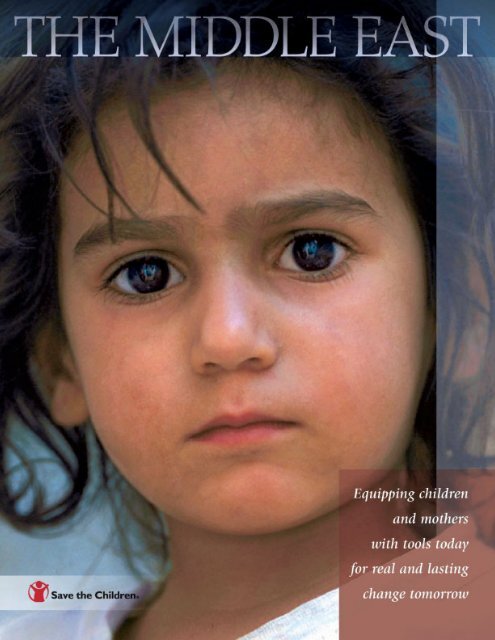

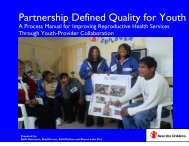

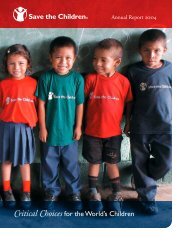
![View full document [PDF 3.39 MB] - PreventionWeb](https://img.yumpu.com/27308954/1/190x245/view-full-document-pdf-339-mb-preventionweb.jpg?quality=85)
